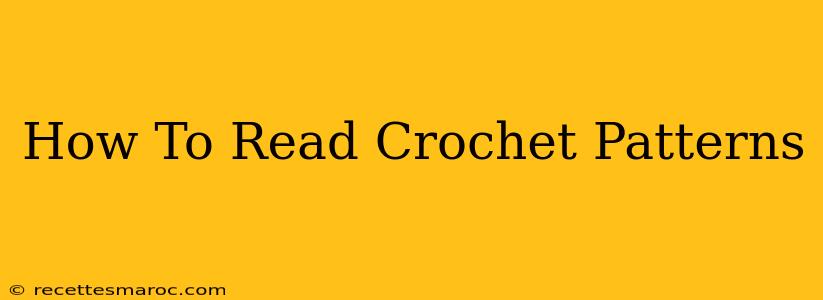So you're ready to dive into the wonderful world of crochet, but those patterns look like a foreign language? Don't worry! Learning to read crochet patterns is easier than you think. This comprehensive guide will break down the essential elements, empowering you to confidently tackle any project.
Understanding the Basics of Crochet Pattern Terminology
Before you can tackle complex designs, it's crucial to understand the fundamental building blocks of crochet patterns. These usually include:
Abbreviations:
Crochet patterns use abbreviations to save space and time. You'll frequently encounter terms like:
- ch: chain
- sc: single crochet
- dc: double crochet
- inc: increase (usually two stitches in one)
- dec: decrease (usually combining two stitches into one)
- sl st: slip stitch
- st(s): stitch(es)
- rnd(s): round(s)
A key to understanding crochet patterns is familiarizing yourself with these common abbreviations. Most patterns will provide a list of abbreviations used at the beginning, but having a general understanding beforehand is beneficial. You can find comprehensive lists online or in crochet pattern books.
Pattern Instructions:
The instructions themselves will follow a specific structure. You’ll typically see instructions broken down by:
- Round or Row Number: Patterns will indicate the round or row number to help you track your progress.
- Stitch Count: Many patterns specify the number of stitches you should have at the end of each round or row. This is crucial for error-checking.
- Instructions: The core of the pattern—detailed instructions on which stitches to use, where to increase or decrease, and how to shape your project. These will usually be written in a concise format using the abbreviations.
For example: "Rnd 1: Ch 4, sl st to first ch to form a ring. Ch 2 (counts as dc), 11 dc in ring. Sl st to top of ch-2. "
Deciphering Common Crochet Pattern Structures
Crochet patterns often follow specific structures, the most common being:
Working in the Round:
This involves working continuously in a circle, creating seamless pieces like hats or amigurumi. You'll typically use a slip stitch to join each round. Instructions are usually indicated with "Rnd" followed by the round number.
Working in Rows:
This involves working back and forth in rows, creating flat pieces like scarves or blankets. Instructions are usually indicated with "Row" followed by the row number. Often, you'll need to turn your work at the end of each row.
Essential Tips for Successful Crochet Pattern Reading
- Start Simple: Begin with easy patterns to familiarize yourself with the format and terminology. Don't jump into complex projects immediately.
- Use a Pattern Notebook: Keep a notebook to jot down notes, make adjustments, and track your progress.
- Read the Entire Pattern Before You Start: This helps you understand the overall structure and identify any potential challenges.
- Don't Be Afraid to Ask for Help: Online crochet communities are incredibly supportive. If you're stuck, don't hesitate to ask for assistance.
- Practice Makes Perfect: The more patterns you read and work through, the easier it will become.
Mastering Crochet Patterns: Your Journey Begins Now!
By understanding these basics and practicing regularly, you'll quickly become proficient at reading crochet patterns and creating your own beautiful handmade items. Remember, patience and persistence are key. Happy crocheting!

